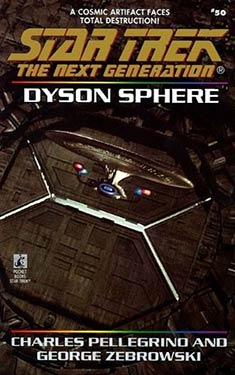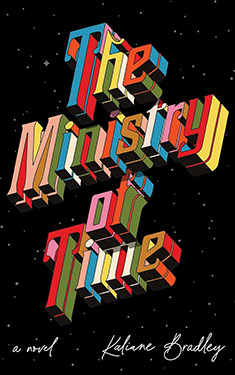
Added By: valashain
Last Updated: illegible_scribble
Dyson Sphere
Synopsis
Two hundred million kilometers across, with a surface area that exceeds that of a quarter-billion worlds, the Dyson sphere is one of the most astounding discoveries the Federation has ever made. Now the U.S.S. Enterprise has returned to explore the awesome mysteries of the sphere. Intrigued by what is possibly the greatest archaeological treasure of all time, Captain Jean-Luc Picard hopes to discover the origin of humanoid life throughout the galaxy -- or perhaps the ultimate secret of the Borg.
But when a neutron star approaches on a collision course with the sphere, a mission of discovery becomes a desperate race against time. The many sentient species inhabiting the sphere face extinction -- can even the Starship Enterprise save them all?
Excerpt
Chapter One
The Shape of Heaven
Tonight, Captain Picard came back again to his mother's old admonition: "Be careful what you wish for, Jean-Luc. You may get it."
Sitting in his ready room, he again played the record of the Enterprise's brief first passage through the Dyson Sphere. He had played it so many times now that his mind was numbed by it, numbed by what a later computer analysis of that scan had revealed. He had believed the Sphere's interior to be completely lifeless, but a detailed examination of the data by newer and more advanced computers had shown a variety -- a nearly infinite variety, Picard supposed -- of plants and vegetation.
But what they had at first concluded remained true: The Dyson Sphere had seemingly been abandoned by whatever life forms had constructed it. The later analysis had revealed no signs of higher life forms, of intelligent life.
Picard thought he knew every river, every stream, every wrinkle in the world's topography, but he understood that the Sphere's size was every bit as deceiving as it was overpowering, and that for all he thought he knew, there was infinitely more he did not know. The only objects the ship's recorders and the later computer analysis might possibly have missed were a couple of twenty-mile-long elephants. What appeared to be a braided stream was really a river wider than the Earth and descending more than two hundred million kilometers from its headwaters; gazing across whole light minutes of land and sea could draw even the most seasoned explorers into moments of madness.
Picard closed the record of the earlier passage through the Dyson Sphere and opened his captain's log to review the most recent entry.
CAPTAIN'S LOG, STARSHIP ENTERPRISEStardate: 47321.6
More than a year has passed since we found Montgomery Scott's ship, the Jenolen, crashed on the outer hull of the Dyson Sphere. More than a year, during which bureaucratic procedure delayed my plans for a return to the Sphere.
We cannot go in until I have assembled my team of Federation-qualified archaeologists. I want scholars who are also efficient excavators -- which means calling on the assistance of Hortas. They can move through rock as effortlessly as a man walks through air. Unfortunately, they are as stubborn as they are efficient -- which has meant more bureaucratic delays.
Two science vessels met us at the end of our first encounter, met us near the Great Wall as we were departing; but the Federation had restricted their exploration of the Sphere entirely to surface mapping and long-range subspace scans. They were under orders not even to try entering Dyson.
Our previous method of entering and exiting the artifact had actually required the destruction of a vessel. The Jenolen held the door to Dyson open while we, in the Enterprise, just barely escaped, having no choice but to fire upon and destroy the vessel blocking our path. We found no obvious way of triggering the exit lock from the inside, and once triggered from outside, a vessel would be hauled in by automatic tractor beams, and the door would close.
Picard closed the log and rubbed at his forehead. He needed a break, a respite from Dyson's vastness, even if it was only a few minutes' escape to a cup of hot tea. Picard heard his mother's voice in his mind once more: Be careful what you wish for, Jean-Luc. You may get it.
He smiled to himself as he realized he was a latter-day Spyridon Marinatos. The legendary archaeologist would have appreciated Yvette Picard's warning, when during the summer of 1967 he tunneled into the lost city of Thera, making the discovery of his dreams, and realizing in that same instant that more than his entire lifetime would be required to excavate it. The city was buried under sixty meters of volcanic tephra, and it spread more than two kilometers wide.
Yet for all its overwhelming size, and for all of Spyridon Marinatos's dismay, Thera could easily have been flung into a corner and never found again, had it been situated near one of the "little" doorways that led into Dyson.
The Sphere was dead, of course. Every analyst had agreed on that much: Dyson was a ghost town built to psychopathic proportion, which gave the captain his long-wished-for kinship with Marinatos. He was, at last, being assigned his own archaeological expedition; but as he remembered how Marinatos had fretted over needing more than his own lifetime to discover and catalogue the artifacts of an extinct civilization, Picard wondered what his Greek predecessor would have thought of a ruin whose exploration might require more than ten billion lifetimes.
Be careful what you wish for --
Now, the Enterprise was approaching "the Great Wall of Dyson," about one hundred light years distant from the Sphere. It was a wall of stars -- an actual wall, beyond which no stars at all could be found. No planets. No comets. No meteoroids. Nothing except...
Picard shivered, recalling his now prevailing, probably correct theory about what had happened to the hundreds, perhaps thousands of star systems that must once have existed on the other side of the wall.
Will there come a time when we know such power? Such arrogance? Picard wondered.
"We shall pass through the wall in fifteen minutes," Data announced over the deskscreen.
"I'll meet you on the bridge in five," the captain said and tensed for a moment, then shut the deskscreen off. He was suddenly and acutely aware that his fellow officer was, like the Dyson Sphere, but the handiwork of a clever species, of a momentarily very successful species, that might or might not become as extinct as the Dyson engineers one day.
Dyson was already an artifact. Data might yet become one.
Clever species, Picard thought, then thought again of all those missing stars between the wall and Dyson, and thought again of power and arrogance.
"What are we going to do with the universe?" he said to the empty room, and winced. "Wherefore, what shall we do?"
* * *
The universe was full of belittling timeframes. For the Horta named Dalen, the last third of her life, all of those years, had passed so quickly that they seemed only a Vulcan lifespan.
How many more years lay ahead? the Horta wondered.
Maybe fifty thousand?
Yes. Fifty thousand, perhaps, but no more.
This was a mere chip of time, scaled against the age of her homeworld, Janus VI, whose oldest rocks had solidified more than seven billion years ago.
"Only the rocks live forever," said the humans. She could scarcely dream what time must mean to them -- to Picard, and to his predecessor, Captain James Kirk, whom her people would always remember as one of those who had brought them out of the darkness.
When Dalen's ancestors already had many millennia of history behind them, there had existed only a few thousand people on Earth, and they had scarcely begun to wrap their minds around the concepts of building huts and milking goats. Yet during the lifetimes of the oldest of the Horta, billions of them had come and gone. Whole empires had come and gone. And the humans, understanding, now, how to milk power from antiprotons and subspace, had come to the stars and showed no intention of ever going away.
And they had carried with them, in their first deep-range exploratory vessel, the Vulcan named Spock, who was said now to be approaching the end of his own unimaginably short lifetime.
Captain Dalen, for her part, barely perceived the paradox. For her, there was only satisfaction in the realization that some part of the Vulcan who had saved her entire species -- had managed to live a little while longer, if only in crude snippets of DNA.
A little while longer ...
It was more than a thousand light years, the Horta knew, from her starship, the Darwin, to the Beta Niobe nova. Curiously, that distant sun could still be viewed starboard and aft, as a dim star circled by a thriving Class M planet.
To the Horta-turned-Federation archaeologist and starship commander, this was the best and worst of times. She oscillated wildly between regret at leaving her quiet life in the caverns of Janus VI, and celebration of escape from her quiet life in the caverns of Janus VI. She was getting used to discovering strange paradoxes in every direction, ever since the humans had opened up the universe to her people. A part of her hated them for this. And a part of her loved them for the same reason.
The surface of Captain Dalen's Homeworld had been nothing except the cold vacuum of empty space, and any who had tunneled straight up and broken through were gushed out, naked, onto an airless deathscape. For their efforts, they left behind only two things: a screaming, outgassing tunnel that had to be quickly sealed, and a very poor inducement for continued space exploration. The theologians and the philosophers around her had declared that there was nothing on the other side of the sky. All life, all matter, and time itself ended at a world-encircling ceiling. And beyond that: nothing. Absolutely nothing.
And then out of nothing, out of that deep, impersonal nothing, had come the miners and the explorers and the starships, bringing with them the tools of subspace communication -- which revealed to the Horta a sky that was full of voices. There had been a time when a nest of newly hatched Hortas had seemed crowded to her, even intimidating. But nothing, it seemed, was so crowded as cold, "empty" space.
One of the most prominent of the latest generation of explorers was, unsurprisingly, also the newest captain of the Enterprise. This Picard fellow wanted to conduct an archaeological survey of the Dyson Sphere now, and he wanted the Darwin's Horta crew on site now. And he had an uncanny way...of getting his way. Captain Dalen's shipping orders had come direct from Starfleet and the Federation Council in San Francisco.
Copyright © 1999 by George Zebrowski
Copyright © 1999 by Charles Pellegrino
Reviews
There are currently no reviews for this novel. Be the first to submit one! You must be logged in to submit a review in the BookTrackr section above.
Images
No alternate cover images currently exist for this novel.



















 Full Details
Full Details





